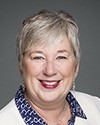There are a lot.
The first point I would make is the one that you just made: we're not alone on this. Parks Canada is a major partner on this. In fact, of the 1% that is protected now, Parks is about half and we're about half. Then there a lot of smaller players. There's also Environment Canada, with migratory bird sanctuaries and those types of things, including other wildlife areas that are in the oceans.
There will probably be maybe three broad strategies—west coast, east coast, north—and they will be unique. We'll have to look at the types of things we'll do. The first is making sure we have the right strategy, and the second is getting the right players around the table. The minister has met with environmental groups, indigenous groups, the fishing industry, and other industry in all of those areas, and talked about engagement. It's about setting the table appropriately.
A huge amount of work has already been done by science to identify ecologically and biologically significant areas. Some of the key stakeholders and environmental groups have done a lot of work as well, as have indigenous groups, provinces, and other partners. It's a question of very quickly pulling together all of that material, identifying the areas we would want to protect, and the measures we would want to apply in those different areas. It's not easy.
So there's all of that to do. It really is about getting the partnerships right. We've established a federal-provincial task group on this. We've pulled together environmental groups in a couple of forums. We've talked to indigenous groups, we've talked to the fishing industry, and it's a question of now getting those things together, pulling together the information we have.
There's one other thing: when exactly is “2017”? Is it January 1, 2017? Is it December 31, 2017? Is it June 8, World Oceans Day, 2017? At this point it makes a big difference.
There are lots of things to consider.




